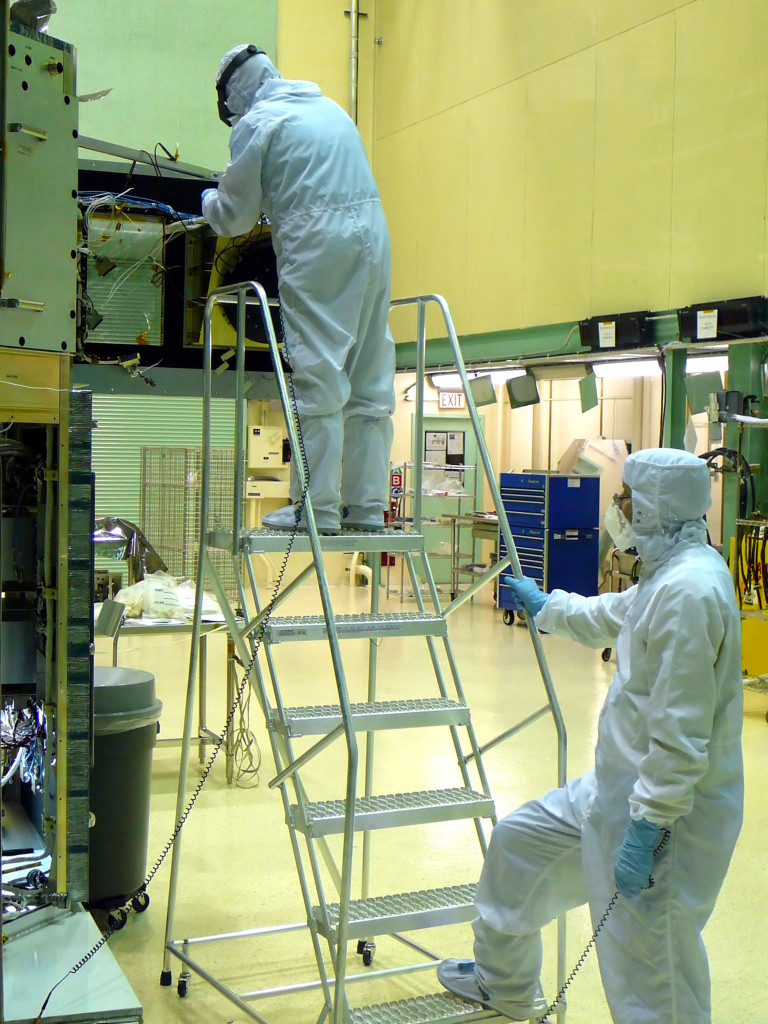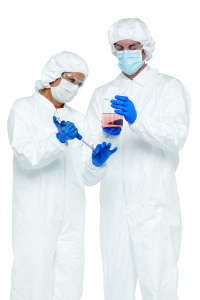
Cleanrooms are spaces that maintain low levels of airborne particulate and viable microorganisms; any liquids and gases entering a cleanroom are purified to maintain the cleanliness level. Businesses that operate cleanrooms may include manufacturers of pharmaceuticals, semiconductors, food products, flat panel displays and memory storage.
In these environments, textiles may be used to prevent contaminants from entering, remove contaminants, prevent contamination by people and prevent contamination from new materials entering the clean space.
Preventing environmental contamination
Air filters installed in the ductwork ensures that clean air enters the cleanroom; most air is recirculated and filtered upon re-introduction. There can be multiple filters: the prefilter removes particles larger than a few microns and protects the downstream high-efficiency particulate (HEPA) filter. The prefilter can be wetlaid glass, as can be the HEPA filter, but in the HEPA filter the glass fibers are very small in diameter. Polyester airlaid nonwovens are often used in prefilters.
All water used in cleanrooms must be highly filtered. In the case of water for injection (WFI), the water must be especially pure because it will be used in drugs that will be injected into the human body.
Removing contaminants
Textile wipes and swabs are used on surfaces within the cleanroom to remove particles, but when impregnated with disinfectants, they also kill micro-organisms. Materials used in wipes require special nonparticulate shedding qualities, so conventional wipes are not suitable for cleanroom applications.

Preventing human and material contamination
Some functions within a cleanroom cannot be handled economically with robotics, so people have to be able to function in a clean space. However, humans shed hundreds of thousands of particles every hour. Their contamination is minimized by essentially encapsulating them in a filter: gowns, masks, gloves and other apparel act as a barrier to prevent particles generated by the wearer from contaminating the air. In the ultra-cleanrooms used for semiconductor manufacturing, breath is also filtered in a design similar to a diver’s helmet.
To prevent contamination from new materials, gowns, gloves, filters and other products used in cleanrooms must be manufactured in cleanrooms and then packaged prior to transport.
Cleanroom markets
Operators of cleanrooms, including those manufacturing pharmaceuticals, semiconductors, aseptically packaged food, flat panels and solar cells, will spend $7.5 billion in 2015 for consumables. This is projected to include gloves at the top of the list at $1.5 billion, and laundry (laundering of reusable garments) at $1.4 billion. Disposable clothing and reusable clothing make up $777 million and $800 million respectively. Wipes are at $890 million and additional supplies make up $1.9 billion.
The largest single purchased product is disposable gloves—universally used in all classes of cleanrooms and in all types of industries. Gloves must be changed each time a worker leaves or enters a cleanroom and must meet requirements for minimal particle shedding and VOC off-gassing. Packaging of gloves to prevent contamination during shipment from the ultraclean environment where they are manufactured to the ultraclean environment where they are unpackaged adds to the cost.
A number of large players are in the market, including Kimberly-Clark and DuPont, which supply single-use garment materials. Reusable garments are often rented; laundries or processors also have to clean these garments in ultraclean environments. Garments are frequently disposed of or cleaned after each exit from the clean space.

The decision for operators is whether to buy single-use garments and throw them away each time a worker leaves the clean environment, or to buy reusable garments and wash them each time. Processors such as Aramark and Prudential Uniform supply reusable garments, which they will wash, seal in airtight packages and ship back to the cleanroom as part of their fee.
Another large company entered the cleanroom industry a few years ago. ITW purchased Texwipe and became a leading supplier of wipes. A number of the glove suppliers are large companies, but much of the manufacturing of wipes, gloves and single use garments is now in Asia.
The supplies market includes special mops, mats and furniture, which have to be built so they do not shed particulate or volatile organic compounds. Two-thirds of the supplies market consists of cleaning chemicals and disinfectants used in cleanrooms.
East Asian purchases of cleanroom consumables are not only larger than other regions, but are growing at a faster rate. This is due to the expansion of the flat panel, semiconductor, solar cell and medical device industries in that region.
The semiconductor industry is on a growth spurt, and that is reflected in revenues for new rooms and in the amount of additional space. This year the semiconductor cleanroom space will increase by 1.62 million ft2 and require investments in cleanroom hardware totalling $634 million. By the end of 2014, more than 210,000 semiconductor employees will be working in clean spaces. This represents about 10 percent of the two million employees working in all cleanrooms, including flat panel, pharmaceutical and other industries.
The Semiconductor Industry Association (SIA) reported the worldwide sales of semiconductors reached $78.47 billion during the first quarter of 2014, marking the industry’s highest-ever first quarter sales. Total semiconductor revenue in 2013 reached $318.1 billion, up from $303 billion in 2012.
China, Taiwan and Korea are enjoying strong sales, but Japan continues to be mired in a slump, with chip revenue for the area declining a steep 17.9 percent.
The use of textiles in cleanrooms is growing due to the expanding industries where cleanrooms are essential, and industries are more willing to invest in products to reduce contamination. There is, however, a trend to replace people in cleanrooms with robotics. This is expensive and only applicable in certain situations, so it is not likely to impact cleanroom textiles’ bright future.
 TEXTILES.ORG
TEXTILES.ORG


